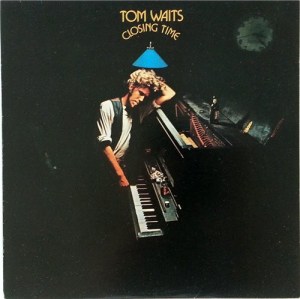More Tom Waits

This copy has the kind of sound we look for in a top quality Tom Waits record: immediacy in the vocals (so many copies are veiled and distant); natural tonal balance (most copies are either bright or dark; ones with the right balance are the exception, not the rule); good solid weight (so the piano and other instruments sound full and powerful); spaciousness (the best copies have studio ambience like you would not believe); and last but not least, TRANSPARENCY, the effect of being able to see INTO the soundfield all the way to the back, where there is plenty going on in this remarkable studio recording.
Some of the more common problems we ran into during our shootouts were slightly veiled, slightly smeary sound, with not all the top end extension that the best copies have.
You can easily hear that smear on the attack of the piano. More often than not the piano notes are a tad blunted, a quality you notice when you finally hear a pressing with the piano notes rendered clearly.
The Piano
If you have full-range speakers some of the qualities you may recognize in the sound of the piano are WEIGHT and WARMTH. The piano is not hard, brittle or tinkly. Instead the best copies show you a wonderfully full-bodied, warm, rich, smooth piano, one which sounds remarkably like the ones we’ve all heard countless times in piano bars and restaurants.
In other words like a real piano, not a recorded one. This is what we look for in a good piano recording. Bad mastering can ruin the sound, and often does, along with worn out stampers and bad vinyl and five gram needles that scrape off the high frequencies.
But a few — a very few — copies survive all such hazards. They manage to reproduce the full spectrum sound of the piano (and of course the wonderful performances of the musicians) on vintage vinyl, showing us the kind of sound we never expected from a old Tom Waits albums like this.
The Making of Closing Time
The main recording sessions for Closing Time took place at Sunset Sound Recorders in Hollywood, California—where Buffalo Springfield, Joni Mitchell, Neil Young and The Doors had previously recorded—during spring 1972. Yester [Jerry Yester, the producer] fronted production and the sessions were held almost immediately after Waits’ record deal, and were described “quick and efficient.”
Waits was “nervous, but confident enough in his own material” during the beginning of the sessions; however, as the sessions progressed, Waits and Yester “were pulling against each other” over the direction which the album would take, with Waits wanting a jazz-laden record and Yester more focused on producing a folk-based album.Despite this, Waits was “absolutely communicative” with his fellow musicians, articulating his direction and using metaphors to describe how he wanted the songs to sound.
The sessions took a total of ten days, with the first two days focusing on “getting used to [the studio].” During the recording of “Ol’ ’55”, Seiter contributed backing vocals and “came up with a perfect harmony line that started faintly before the chorus even began.” The sessions concluded with a total of nine songs completed. Though unsatisfied with the amount of songs, a second recording session was arranged the following week in United Western Recorders.
The final session for Closing Time began the following Sunday, with guest musicians Arni Egilsson replacing Plummer and Jesse Erlich performing cello.
The title track, “Closing Time”, was the only song recorded in full, and Yester later described the session as “the most magical session I’ve ever been involved with. At the end of it, no one spoke for what felt like five minutes, either in the booth or out in the room. No one budged. Nobody wanted the moment to end.”
String overdubs were later cut for “Martha” and “Grapefruit Moon” the following day. The final recordings were mixed and mastered at Wally Heider Studios in San Francisco.
Wikipedia
TRACK LISTING
Side One
Ol’ ’55
I Hope That I Don’t Fall In Love With You
Virginia Avenue
Old Shoes (& Picture Postcards)
Midnight Lullaby
Martha
Side Two
Rosie
Lonely
Ice Cream Man
Little Trip To Heaven (On The Wings Of Your Love)
Grapefruit Moon
Closing Time
AMG 4 1/2 Star Review
Tom Waits’ debut album is a minor-key masterpiece filled with songs of late-night loneliness. Within the apparently narrow range of the cocktail bar pianistics and muttered vocals, Waits and producer Jerry Yester manage a surprisingly broad collection of styles…
Closing Time announces the arrival of a talented songwriter whose self-conscious melancholy can be surprisingly moving.
Wikipedia
Upon its release, Closing Time was received by the American music press with positive critical acclaim, although its coverage was limited.
In its original Rolling Stone review, the album was positively referred to as “a remarkable debut album”, compared to Randy Newman, and was branded as a “boozier, earthier version of same and delights in rummaging through the attics of nostalgia, the persona that emerges from this remarkable debut album is Waits’s own, at once sardonic, vulnerable and emotionally charged” while former Village Voice editor and Pazz & Jop reviewer Robert Christgau noted that with his “jazz-schooled piano and drawling delivery […] Waits exploits an honest sentimentality which he undercuts just enough to be credible”, also noting his similarity to Newman.
Allmusic held the album in high regard, describing “his lovelorn lyrics” as being “sentimental without being penetrating. But he also has a gift for gently rolling pop melodies” and his “self-conscious melancholy can be surprisingly moving.” Billboard referred to Closing Time upon its release as “a hauntingly lovely new album of introspective songs and folk/jazz music which captures the essence of a moment, a thought or a love.